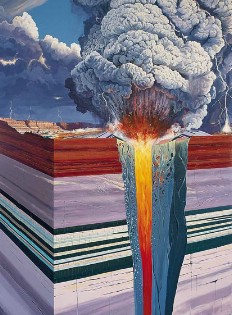Pipes Formation Location Mines
Kimberlite Pipes

An easy way to see a kimberlite pipe is first hand, like a miner or geologist, in the tunnels that provide access to the pipe in an underground mine. The tunnel recreated in the exhibition goes from the local bedrock, through a boundary zone which is highly fragmented, and in turn into the kimberlite, with its inclusions of mantle rocks and diamonds.
In a tunnel that contains a kimberlite pipe, you might be able to see the following:
Shattering of local bedrock and mixing with kimberlite in the boundary zone:
This illustrates that the eruption was extremely violent, explosive in its early stages.
Mica:
In addition to mica, the tunnel contains calcite that is invisible. Larger proportions of these minerals are very unusual in an igneous rock. There is water in mica and carbon dioxide in calcite, representing abundant gas dissolved in the magma. The gases bubbled out of the magma and pushed into the violent eruption -- like uncorking a bottle of hot champagne.
Round and angular pieces of rocks in the kimberlite:
These are xenoliths, foreign rocks in the kimberlite. They were forced out from Earth's mantle by the rising magma. These rare samples are much valuable to geologists studying Earth's interior and the origin of diamonds.
Red garnets and a diamond: Both minerals are found in kimberlites and in some sort of the xenoliths. Certain garnets would indicate the presence of diamonds.